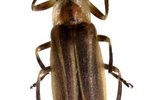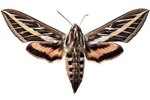
The crane fly goes through a metamorphosis or changes body types during its lifecycle that lasts approximately one year. From the time the female lays her eggs until they reach adulthood, the fly changes from a larva to a pupa, then to an adult. Each cycle serves a specific purpose for growth and development of the crane fly.
Description
According to the Carnegie Museum of Natural History, more than 1,500 species of crane flies have been identified in North America. Each type has unique characteristics. However, the adult mosquito-like fly generally has an elongated body up to 3 inches long, a pair of slender wings that spread up to 3 inches wide, and six long, skinny legs. Unlike the mosquito, the crane fly is harmless and does not bite.
Eggs and Larvae
The female crane fly generally lays her eggs in water, such as lakes or creeks, or in moist soil or on lawns during the spring. She may lay hundreds of eggs at a time, which generally hatch within 6 to 14 days. The first stage after hatching underwater or underground is the larval stage. The larva of the crane fly is shaped like a worm with both ends tapered. It has a tough outer skin covered with tiny hairs. During this larval stage the gray, brown- or cream-colored fly larvae feed off of leaves, roots and debris in the soil or water.
Pupae
The pupae form after the larvae have eaten for several months and molted, or lost and replaced their skin, four times. During this stage, the crane fly rests between one week and several months while under protective cover. Generally, during the spring, the pupae emerge as adult crane flies.
Adult
The main goal of the adult crane fly in the spring is mating. During the adult stage, the crane fly does not eat. For the short 10- to 15-day period, the adults mate on plants or in the air near the water. Afterwards, the female deposits her eggs. When mating and egg distribution is complete, female dies. The male only lives up to 15 days as well.
References
Resources
Photo Credits
-
Hemera Technologies/PhotoObjects.net/Getty Images
Writer Bio
Amanda Maddox began writing professionally in 2007. Her work appears on various websites focusing on topics about medical billing, coding, real estate, insurance, accounting and business. Maddox has her insurance and real estate licenses and holds an Associate of Applied Science in accounting and business administration from Wallace State Community College.




